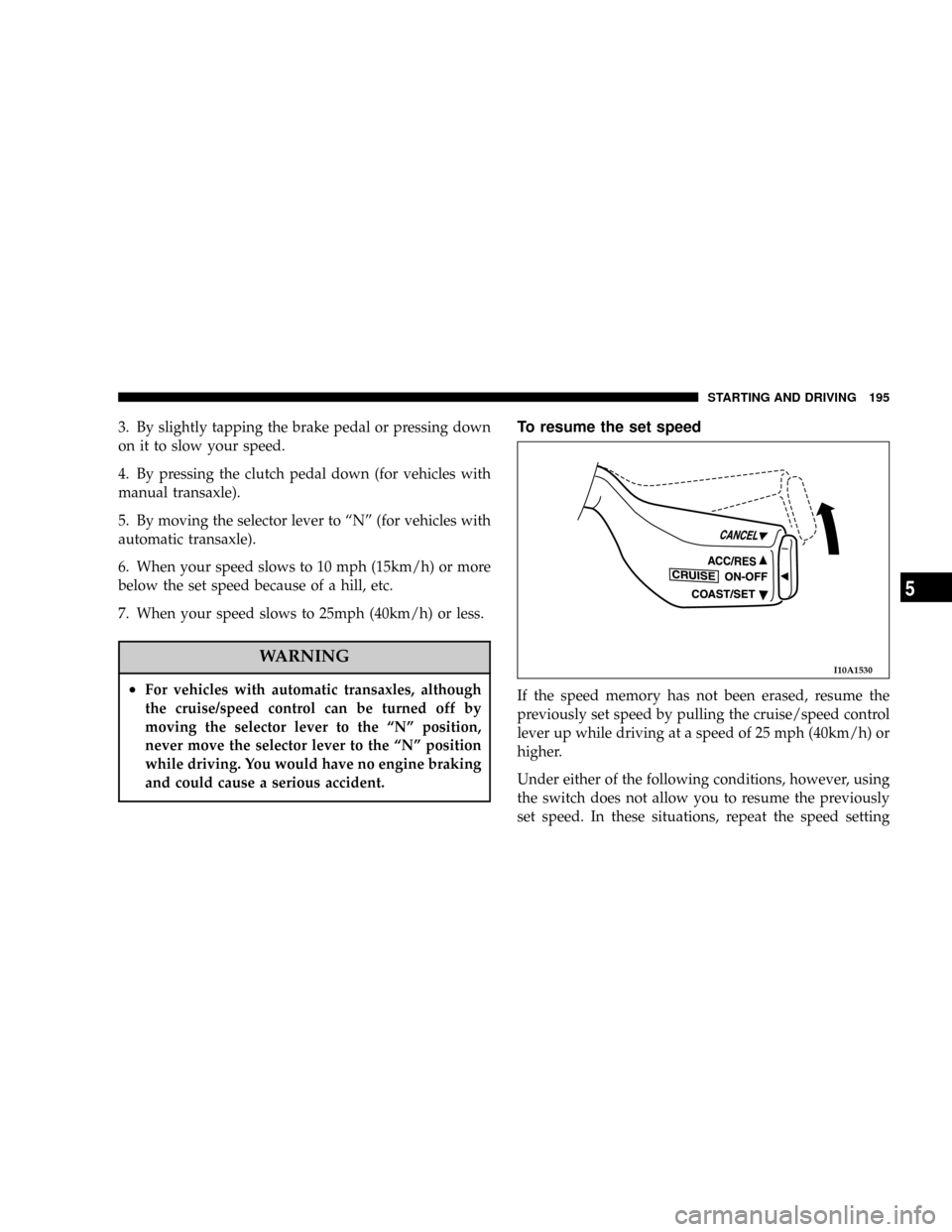Page 195 of 388

3. By slightly tapping the brake pedal or pressing down
on it to slow your speed.
4. By pressing the clutch pedal down (for vehicles with
manual transaxle).
5. By moving the selector lever to ªNº (for vehicles with
automatic transaxle).
6. When your speed slows to 10 mph (15km/h) or more
below the set speed because of a hill, etc.
7. When your speed slows to 25mph (40km/h) or less.
WARNING
²For vehicles with automatic transaxles, although
the cruise/speed control can be turned off by
moving the selector lever to the ªNº position,
never move the selector lever to the ªNº position
while driving. You would have no engine braking
and could cause a serious accident.
To resume the set speed
If the speed memory has not been erased, resume the
previously set speed by pulling the cruise/speed control
lever up while driving at a speed of 25 mph (40km/h) or
higher.
Under either of the following conditions, however, using
the switch does not allow you to resume the previously
set speed. In these situations, repeat the speed setting
I10A1530
STARTING AND DRIVING 195
5
Page 200 of 388

Check wheel nuts for tightness and tires (including spare
tire) for proper pressure. Maintain specified tire inflation
pressures. Replace tires before they are excessively worn.
Lights
Have someone observe the operation of all exterior lights
while you activate the controls. Check the turn signals
and highbeam indicators on the instrument panel.
Fluid leaks
Check the area under the vehicle after overnight parking
for fuel, water, oil, or other fluid leaks. Make sure all fluid
levels are at the proper levels. Also, if fuel leaks are
detected, the cause should be located and corrected
immediately.
Driver
Do not drive if you are tired or sleepy. Do not drive if you
have been drinking or taking drugs. Unless you are alert
and able to concentrate on your driving, you could have
an accident, resulting in serious or fatal injury to yourself
and others.
SAFE DRIVING TECHNIQUES
Even this vehicle's safety equipment, and your safest
driving, cannot guarantee that you can avoid accident or
injury. However, we recommend that you give extra
attention to the following, to help maximize the safety of
you and your passengers:
1. Drive defensively. Be aware of traffic, road and
weather conditions. Leave adequate stopping distance
for your vehicle.
2. Before changing lanes, check your mirrors and flash
the proper turn-signal light.
3. While driving, watch the behavior of other drivers,
bicyclists and pedestrians.
4. During an emergency stop, switch on the hazard
warning flasher.
5. When leaving the vehicle, set the parking brake and
place the gearshift lever into low gear.
In vehicles with an automatic transaxle, place the selector
lever in the ªPº (PARK) position. Remove the key.
200 STARTING AND DRIVING
Page 203 of 388

WARNING!
Never open the radiator cap when the radiator is hot.
You could be seriously burned.
TRAILER TOWING
Warranty Requirements
The Manufacturer's Passenger Vehicle Warranty will
apply to vehicles used to tow trailers for non-commercial
use. However the following conditions must be met:
²The maximum trailer load for vehicles with manual
transaxles is 1,000 lbs (454 kg).
²The maximum trailer load for vehicles with automatic
transaxles is 1,000 lbs (454 kg).
²The maximum frontal area of the trailer cannot exceed
20 square feet (1.86 square meters).
²If using a manual transaxle vehicle for trailer towing,
all starts must be in FIRST gear to avoid excessive
clutch slippage.The trailer tongue load must be considered as part of the
tow vehicle load capacity when loading the vehicle.
NOTE:Check the automatic transmission fluid level
before towing. Fluid discoloration, or a burnt odor,
shows the need for transmission fluid replacement.
WARNING!
Connecting trailer brakes to your vehicle's hydraulic
brake lines can overload your brake system and
cause it to fail. You might not have brakes when you
need them and could have an accident.
Whenever you pull a trailer, regardless of the trailer size,
stop lights and turn signals on the trailer are recom-
mended for motoring safety.
STARTING AND DRIVING 203
5
Page 243 of 388
Air conditioning switch
The air conditioning can be operated while the engine is
running.
Push the switch, and the air conditioning (cooling/
dehumidifying function) will operate. When ªONº, the
operation indicator lamp (A) will illuminate.
Push the switch again and the air conditioning will stop.
CAUTION!
When using the air conditioning, the idle speed is
slightly increased. Therefore, make sure your foot is
firmly on the brake pedal when shifting the trans-
mission to drive.
For the 3.0 liter engine model, if the air conditioning
indicator (A) blinks, it is suspected that something is
wrong with the air conditioning. Move the vehicle to
a safe place and stop the engine. Then run the engine
again and see the air conditioning indicator (A). If
the indicator goes out, there is nothing wrong with
the air conditioning. If it blinks again, have the
system checked by the authorized dealer.
H23A3260
FOR PLEASANT DRIVING 243
6
Page 258 of 388

Polishing your vehicle
If painted surfaces have been severely damaged and lost
their original luster and color tone, polish the surface
lightly with a fine polishing compound. Avoid limiting
your polishing to the damaged surface only; polish a
somewhat wider area, moving the polishing cloth in one
direction. After polishing, flush the compound from the
surface and apply a coat of wax to regain a beautiful
luster.
Damaged paint
Small cracks and scratches in the paint coat should be
touched up as soon as possible with touch-up paint to
prevent corrosion.
Check body areas facing the road or the tires carefully for
damage to the paint coat caused by flying stones, etc. The
paint code number for your vehicle can be found on the
vehicle information code plate in the engine compart-
ment.
Cleaning plastic parts
Use a sponge or chamois.
If vehicle wax adheres on the plastic bumper or mold-
ings, the surface may appear white in color. In this case,
wipe it off using lukewarm water and a soft cloth or
chamois.
CAUTION!
²Do not use a scrub brush or other hard tools as
they may damage the plastic part surface.
²Do not use wax containing compound (polishing
compound) which may damage the plastic part
surface.
²Do not bring plastic parts into contact with brake
fluids, engine oils, greases, thinner for painting,
and sulfuric acid (battery electrolyte) which may
stain, crack or discolor the plastic parts.
If they touch the plastic part, wipe them with a
soft cloth, or chamois and an aqueous solution of
neutral detergent. Then, immediately rinse the
affected parts with water.
258 VEHICLE CARE
Page 261 of 388

EMERGENCIES
CONTENTS
mIf the vehicle breaks down................263
NIf the engine quits.....................263
mOperation under adverse driving conditions...263
NIf your vehicle becomes stuck in sand, mud or
snow..............................263
NOnawetroad........................264
NOn snowy or icy roads..................265
mSpare tire, jack and tool set storage.........266
NHandling spare tire....................266
NJack...............................267
mCompact spare tire.....................267
mWheel covers (if so equipped).............268
mJacking and tire changing................270
NJacking up the vehicle..................270
mEngine overheating.....................278
mJump-starting the engine.................279
NIf your vehicle has anti-lock brakes.........284
mTowing..............................284
mFuses...............................286
NFuse block...........................286
mFusible links..........................287
NFuse load capacities....................287
mReplacement of light bulbs................292
NBulb capacity.........................292
8
Page 263 of 388

IF THE VEHICLE BREAKS DOWN
If the vehicle breaks down on the road, move to the
shoulder and activate the hazard warning flashers. If
there is no shoulder, or the shoulder is not safe, drive in
the right lane, slowly, with the hazard flashers activated,
until you reach a safe place to stop. Keep the flashers
activated.
If the engine quits
If the engine stops, power will be lost to the steering and
brakes, making steering and braking difficult.
1. The brake booster becomes inoperative and the brake
pedal will be harder to push than usual.
2. Since power steering system is not operative, the
steering wheel will be stiff when turning. Turn the wheel
with more effort than usual.
OPERATION UNDER ADVERSE DRIVING
CONDITIONS
If your vehicle becomes stuck in sand, mud or
snow
If the vehicle becomes stuck in snow, sand, or mud, it can
often be moved by a rocking motion. Turn your steering
wheel right and left to clear the area around the wheels.
Move the gearshift lever or selector lever rhythmically
between the 1st and REVERSE position (with manual
transaxle), ``L'' (Low) and ``R'' (REVERSE) position (with
automatic transaxle), Autostick and ``R'' (REVERSE posi-
tion (with automatic transaxle autostick), while applying
slight pressure to the accelerator pedal.
Avoid racing the engine or spinning the wheels. Pro-
longed efforts to free a stuck vehicle may result in
overheating and transaxle failure.
Allow the engine to idle for a few minutes to let the
transaxle cool between rocking attempts.
If the vehicle remains stuck after several rocking at-
tempts, seek other assistance.
EMERGENCIES 263
8
Page 264 of 388
WARNING!
When attempting to rock your vehicle out of a stuck
position, be sure that the area around the vehicle is
clear of people. The rocking motion may cause the
vehicle to suddenly lurch forward or backward,
causing injury to by-standers.
On a wet road
CAUTION!
²Avoid flooded roads. Water depth can be decep-
tive, and you could be seriously hurt by driving
into flood water.
²When driving in rain, on water-covered roads, or
through a vehicle wash, water could enter the
brake drum linings or discs, resulting in tempo-
rarily ineffective brakes. In such cases, lightly
depress the brake pedal to see if the brakes
operate properly. If they do not, lightly depress
the pedal several times while driving in order to
dry the brake pads or linings, then check them
again.
264 EMERGENCIES